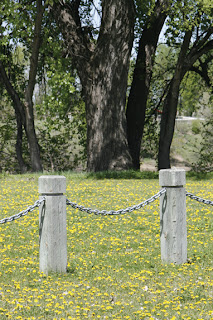The area in front of and in back of the point of focus that appears sharp to our eyes is the image’s depth of
field. Stopping down the lens will increase this area of apparent sharp focus while opening up the lens will diminish it. The closer you are to your subject, and with an opened aperture, the less depth of fi eld. This is useful to isolate a subject against an otherwise cluttered or distracting background (FIGS 1.4 and 1.5).
FIG 1.4 At f22 the background is too confusing to make sense out of this close up, while a slight breeze was
enough to blur the subject
FIG 1.5 At f2.8, the shutter speed is high enough to freeze any movement, and the background is so soft
that the subject stands out nicely
Shutter Speed
See also Aperture, Depth of Field, and Reciprocity.
The amount of time a shutter remains open to allow light to strike the camera’s sensor is the camera’s “shutter speed.” A shorter time duration (aka “faster”) means more action can be stopped, or frozen. Conversely, slower shutter speeds (a.k.a. “longer”) allows action to blur. Under many circumstances, longer shutter speeds will necessitate smaller apertures, increasing depth of fi eld (FIGS 1.6 and 1.7).
FIG 1.6 A very fast shutter speed of 1/1000th second (at f6.3) was fast enough to freeze the rapidly moving water.
FIG 1.7 With the help of neutral density f lters, a shutter speed of 6/10th second (at f22) was slow enough to gracefully blur the roiling water.
When a shutter speed actuation is made slower (by the shutter’s equivalent of a full stop), the amount of time that light plays on the chip is doubled. Changing the shutter speed in such a manner without correspondingly adjusting the aperture will result in an image overexposed by one stop. When a shutter speed actuation is made faster (by the shutter’s equivalent of a full stop), the amount of time that light plays on the chip is halved. Changing the shutter speed in this manner without a corresponding change in f-stop will yield an image underexposed by one stop (FIGS 1.8–1.10).
FIG 1.8 One stop overexposed
Canon cameras off er a range of shutter speeds from 30 seconds to 1/4000th of a second (on the Rebel) to a maximum of 1/8000 (on other models). All cameras have provision for Bulb exposures, where the shutter
stays open as long as it’s depressed. Custom Function (C.Fn) 6 (on most cameras) permits you to choose intermittent shutter speed increments in ½ stops (camera default is 1/3 stop increments).
FIG 1.9 Correct exposure
FIG 1.10 One stop underexposed
If you like this post, please say thank and if you can, please make some donation as much as you can to support....


















0 comments:
Post a Comment